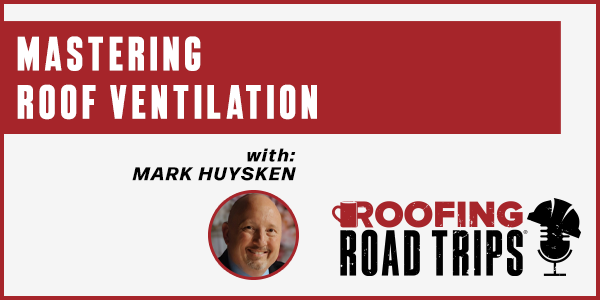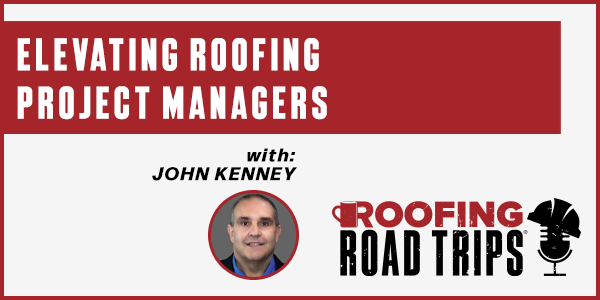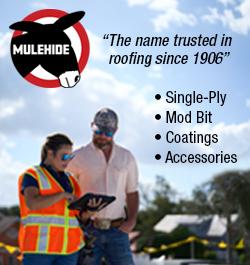Mark Huysken - Mastering Roof Ventilation - PODCAST TRANSCRIPT
February 4, 2025 at 6:00 p.m.Editor's note: The following is the transcript of a live interview with Mark Huysken of Quarrix. You can read the interview below or listen to the podcast.
Intro: Hello everyone and welcome to another episode of Roofing Road Trips from Roofer's Coffee Shop. My name's Karen Edwards and today's episode is gonna be all about ventilation. Super important in roofing and performance and to talk, have this conversation, we have invited Mark Huysken from Quarrix. Mark, welcome.
Mark Huysken: Hey Karen, thank you so much for having me. I appreciate the opportunity.
Karen Edwards: Mark, just take a minute, introduce yourself, tell us about what you do there at Quarrix.
Mark Huysken: Yeah, absolutely. So I'm a strategic account manager, sort of a regional sales role with national responsibilities. I've been with Quarrix about five years now, or just past five years actually. So, which is great. And I manage a team in the central US of sales folks who are out selling Quarrix products. And then as I mentioned, I also handle some of our national accounts and I work closely with marketing and some other projects as well.
Karen Edwards: Excellent. Well, thank you so much for being here today. I want to get started just by talking a little bit about why proper attic ventilation matters in a home.
Mark Huysken: Thank you.
Mark Huysken: Yeah, absolutely. Proper attic ventilation is so critical. It's kind of critical, like, you know, changing the oil in your car. You know, it's something we don't think about very often, but we need to take care of, right? So we need to make sure that the attic is properly ventilated. One of the misconceptions about attic ventilation is that it's about letting air out. But the way we breathe in our lungs, we can exhale only for so long we have to inhale to.
So we have to think of our attic sort of like a set of lungs and the attic has to inhale just like it has to exhale. You know, we're primarily focused on the exhaust side as a ridge vent manufacturer, but the intake side is also so critical as well. And we sell some components along those lines, but absolutely it has to breathe. You have to get the, in the warmer months, we need to get the hot air out. We need to have good air exchanges.
And in the colder months, need to get the moisture out especially because the moisture can build up and cause a lot of problems.
Karen Edwards: That's what was just going to say. What happens if you don't have that proper airflow in the attic?
Mark Huysken: Yeah, a lot of, a lot of bad things really can happen. you know, when it comes to the, to the heat, you know, the attic temperature can just be, can be just amazingly hot compared to what it is outside. You may have a degree, a day outside that's 80 or 90 degrees. And if your addict's not breathing properly again, balanced intake and exhaust is the breathing. It's not breathing properly. That addict can be 30, 40, 50, 60 degrees hotter.
Karen Edwards: Yeah.
Mark Huysken: than what it is outside. So what that heat is going to do in the attic is a couple of things. One is it's going to cause your cooling bill, if you're running air conditioning to rise because the heat is built up in the attic and it actually wants to, it'll start feeding its way down into the home, which isn't great. But also the hot air that's up in the home can't find a way out either because the hot air always rises. It's just the stack effect. It's a natural thing.
And then when you have all that heat buildup and sometimes moisture as well in the summer as well, it can cause all kinds of damage to the structure in the attic. The wood, your decking, decking can warp. If you've ever seen a wavy roof, that's usually caused by heat buildup and moisture buildup and those sorts of things. And of course it can destroy the shingles. The shingles are great. There's a lot of great shingle manufacturers. They're all doing a pretty good job these days with their shingles.
Karen Edwards: Yeah.
Mark Huysken: But they can't withstand attic temperatures of 140, 50, 60 degrees. It's just going to bake those shingles and ultimately it could void the warranty. Most shingle manufacturers have it in their warranty in the fine print or not even the fine print. I'd say it's in bold print that inadequate attic ventilation can void the warranty. And it's not their way of trying to get out of it. It's just their way of trying to say, take care of things. Go back to the oil change.
Karen Edwards: Mm-hmm.
Mark Huysken: You know, if you buy a new car and you never change the oil and at 50,000 miles, your car blows up and you go to the dealer and the dealer goes, well, golly, you've never changed your oil. You know, you have to do some maintenance to take care of it. And that attic ventilation is a big part of that maintenance. Good intake, good exhaust and balance the system. So critical. Let's talk about winter. Winter can be worse at times because of the moisture buildup and the colder climates.
Karen Edwards: You
Mark Huysken: What happens is you get a lot of moisture buildup in there and it's not exhausting out. And what can happen in the real cold climates, I live in Michigan, it can happen here, is you can get moisture buildup on the nails that are sticking through the roof deck, any metal flashing metal that's on the trusses, you know, where the truss pieces come together, all of those metal pieces can hold the moisture and then it freezes because it's cold, right? So then what happens is the attic warms up on a warmer day or a sunny day.
And that water that's been built up on the metal is going to go somewhere and it's not going to go out. It's going to drip down into the insulation. So I get a few calls a year and I'm sure the roofers understand this. They get a lot of call the roofing professionals for leaking attics or look, I'm sure they'll say a leaking roof. They'll say the roof is leaking. And the reality, the roof is probably not leaking. It might be that the attic had built up moisture from the humidity, from lack of breathing, lack of
Karen Edwards: Mm-hmm.
Mark Huysken: Good ventilation and that water just had to find somewhere to go. It ruins the insulation in the bottom on the floor of the attic and it also can leak into the home. Sometimes you'll see a home with little water spots in the ceiling and that's oftentimes what caused that. It wasn't a rain day, was a cold spell where moisture built up in the attic and then it finally melted and just dripped down.
Karen Edwards: Wow. Yeah, that's incredible how you got to let it breathe. You got to let it get out of there or it can really, really cause damage. So let's talk about what Corix, you are a Ridge Vent manufacturer and let's talk a little bit about Storm Stop. Give me a little bit of history about that. And I know you're a little different from, I don't know if I want to say traditional Ridge Vents, but let's talk a little bit about that product and what makes it different.
Mark Huysken: Absolutely.
Mark Huysken: Yeah, absolutely. Yeah, we are a little different looking. You know, there's a lot of a lot of the ridge vents that are well known. Well, are made of polypropylene plastic and they have an external baffle. That external baffle is kind of like a wall of protection, you know, that that's sticking out from under the shingle. So when you can physically see the ridge vent sticking out beyond the shingle, that's a baffled, typically a baffled polypropylene ridge vent.
We're a high density polyethylene plastic. So HDPE is a stronger plastic. It's a more durable plastic. It's definitely tougher in colder climates and in hot climates, meaning that you don't, the temperature swings don't impact it as much. Our product can be installed in the winter and it can be installed in the summer. It doesn't make a difference. But also what's different is we don't have an external baffle. We don't need the external baffle.
So the ridge vents that have the external baffle, that baffle, the purpose of that baffle, the number one purpose is to stop wind-driven rain and snow. You know, as you have a heavy rain or wind-driven snow and it's coming up the roof deck, it's gonna hit the baffle on the competitor and it's gonna be deflected away. It's basically a deflector and it does its job. If you cut that deflector off, the rain or snow would find its way into the attic very quickly.
When you look at ours, we don't have a deflector. We don't need a deflector. Our unique design allows us to handle those that wind driven rain or snow head on. We don't we don't need something in front of us, basically, to stop it. We have kind of a unique corrugated plastic design. Some folks look at it and can't quite wrap their head around it because they think of corrugated plastic as something that should be made for a box. Right. But.
Karen Edwards: Right. Yeah.
Mark Huysken: But for a Ridgevent, it actually works really well. We started making our Ridgevent in the 90s. We were actually one of the first Ridgevent manufacturers way back then. And we've really made basically one change in 2000. Other than that, it's been a time tested product. We have all of the same certifications as all the other Ridgevent manufacturers and then some. We're on millions and millions of homes all over the world. We sell into multiple countries and we just don't have issues in all climates.
It works very, very well. Being a corrugated plastic, we have very small holes and we have thousands of small holes. And it's very difficult for rain or snow to get into those holes. And then if by some chance some rain or snow got up into the holes, which it's a three inch path that it has to pass through. I mean, think of a bunch of tiny straws, right? If we were to get past that, we have a membrane that's incredibly unique.
Karen Edwards: Right.
Mark Huysken: That is really what is going to be the last and best line of defense.
Karen Edwards: Okay, and what is that membrane made out of?
Mark Huysken: So our membrane is a spun-bonded polypropylene. If you think of just like something that's very tightly woven and the way that it works, it was engineered to be 29 % closed, but that means it's engineered to be 71 % open. What the 29 % closed does is stops water and snow. We can literally pour water onto our membrane and the water doesn't go through.
Karen Edwards: In.
Mark Huysken: The water molecules, the snow molecules are too big. They can't pass through because the way it's tightly woven. Think of like a premium house wrap that allows for breathing. Same thing. So it's that 71 % of open. That's what really counts. And that 71 % of open membrane is what allows the hot air to escape out of the attic. It gets through the membrane and then through our long three inch flutes to get out of the attic. As long as you have proper intake to...
Create that balance. It's going to do exactly what it's supposed to do. But in the rare instance that again that snow or rain gets past our our three inch flutes, that membrane is there to stop everything else. And I said we made one change to our ridge vent. was in 2000 we added that membrane. So millions of homes with the membrane, with our design and it just works beautifully.
Karen Edwards: No issues. Yeah. Wow. it's installing. Is it different than a traditional? What's that look like?
Mark Huysken: Yeah, absolutely. So there's two ways to install ridge vents, right? You can use a hand nail them. You can use a hammer and nail them in with like a two and a half inch, three inch nail. Most of the four inch section, the four inch stick products require a nail. I'm sorry, a two and a half inch or three inch nail with a hammer, hand nailing. The rolled products can vary between gun nails or hand nails.
In our instance our product whether you use our four foot stick or our or 20 foot roll if you're using our 5-8 low profile It can all be gun nailed Which is great because when you can gun nail it it goes on quickly you use an inch and three-quarter nail and the in your Roofing gun and it goes on quickly and it saves you time something else It's incredibly unique about our product is you don't have to nail our product every 6 to 12 inches
Every competitor will require in their installation instructions that you have to put two nails every six inches or two nails every 12 inches It's a lot of nails Before you put down the hip and ridge cap before you put down the shingle cap Because the shingle caps come gonna follow and put another two nails every five or six inches So when you put our ridge vent down, let's just take our 20-foot roll For example, you're gonna put four nails at the beginning of the roll and then you can unroll it out 10 feet before you nail it again
So two nails at 10 feet. Yeah, yeah. And then four more nails at the other end of that 20 feet. So on that 20 foot roll, it took 10 nails to install it. And it's a quick and it's an easy product to install. We have little foam end caps that just pop in real quickly and easily at both ends. And then you're just gonna peak the product like you anything else. Because what happens is once you have installed our ridge vent,
Karen Edwards: Really?
Karen Edwards: Wow.
Mark Huysken: It's a very rigid, stiff product. Once you install it, you're going to go back over with the hip and ridge. So we're kind of putting, holding it in place, putting your finger on it, if you will and holding it in place until you can, because you're going to come back through and gun it down again with the hip and ridge. And again, can be the hip and ridge can also be gunned down. So that's something that's unique as well. It's going to save some time. As long as you're getting into the substrate, into the decking with three quarter inch of the nail, you should be fine. Whereas the
Karen Edwards: Mm-hmm.
Mark Huysken: The more common four foot sections, our competitors, the hip and ridge cap also has to be nailed in with two and a half inch or three inch nails all by hand. So I love with our product, you don't need a hammer on the roof. You can just keep gunning and you'll get home faster or get to the next job faster.
Karen Edwards: Yeah, yeah, it saves time, right? And doesn't everybody want to do that?
Mark Huysken: Absolutely. Yeah, absolutely. Absolutely. It's the last thing you're doing on the house. You want to get out of there.
Karen Edwards: Yeah, yeah, you're almost done. So yeah, let's make it make it faster and easier without jeopardizing quality, right? Yeah, okay. So now I want to talk a little bit about when you have your product at events and trade shows, you have a smokehouse, right? That demonstrates what happens. And I know you mentioned that you guys recently recorded a video.
Mark Huysken: Correct, absolutely.
Karen Edwards: To demonstrate how the products work. Can you just tell me a little bit about that? what am I looking for when I'm seeing this smokehouse? What are you trying to show me?
Mark Huysken: Yeah, absolutely. What we're trying to show with the smokehouse is that the product can breathe. What happens with our competitors, they will take our membrane and they will say, look, nothing passes through, air doesn't go through. It kind of beat up on the membrane. They sort of create a misconception that air cannot pass through. And we talked about it already. It's engineered that 71 % of airflow goes through it. And that's all tied into our system.
Some of our competitors have smoke houses as well. What the smoke houses basically show is that, hey, air is going to go in and air is going to go out. It's that simple. And that's what we're trying to accomplish with the attic. So our smokehouse allows allows people to see that that does work, that the membrane does work. As a matter of fact, I was involved in the design and building of it. And I I made sure that when we when we installed that ridge cap and the the ridge vent.
That the smoke was not going to go anywhere, but through our membrane and through our through our three inch flutes. And it and it just billows like crazy when we fire up the smoke. mean, the the fresh air comes in and pushes the smoke out and does exactly what it should do. It's just it's a little bulky to carry around. I can't check it on a plane. So so we so we created a professional video last week. We'll be rolling that out probably next month. Something that's easy to show somebody from a phone or a tablet or
Karen Edwards: Right?
Mark Huysken: Or email a link and post on social media, that sort of thing, just to combat the misconception that the Quarrix Stormstop doesn't breathe because it breathes incredibly well. So we just really wanted to put out this video to show how well it breathes. there's no smoking mirrors to it. just it's is theater smoke. And that's what everyone uses because you don't want to use real smoke inside. Right. But
Karen Edwards: Sure.
Mark Huysken: But it's a matter of pushing that smoke with the fresh air that's coming in. And so the stack effect causes it to rise and go out through the membrane and pass through the flutes. it's just a great, it's a great show of how well it works.
Karen Edwards: I would imagine that it would be very useful for a contractor perhaps to demonstrate to a homeowner the concept of, know, we need to do some work on your ventilation, you know or installing your new roof. So that's, that's going to be a nice and convenient thing to have.
Mark Huysken: Absolutely. I definitely would agree with you. I do a lot of ventilation trainings around the country and I really try to emphasize a couple of things to contractors. Biggest thing is do it right. You're selling probably some sort of a lifetime shingle system, maybe a full system, but some sort of a life. They're all pretty much a lifetime or a limited lifetime warranty. When you sell that to somebody that you want to make sure the warranty is going to uphold because you're doing a proper attic ventilation in the process. And that might cost more because you may have to go in and actually do some modifications to their intake. That's usually the case. There's usually not enough intake. And also we have to be careful not to put too much exhaust. We want to balance the system. So in the process of doing that, a video like our smokehouse might help to explain that to a homeowner. A lot of times they'll look at their home and they'll go, you know, it's been fine. I haven't had issues. Why would I have issues now? Well,
Karen Edwards: Mm-hmm.
Mark Huysken: The roof deck has changed. The envelope has changed. The system has changed. When we tear off a 20-year-old roof, we're not putting on the same roof. We might be redecking it, whether we are or not. We're sealing up the deck like we've never sealed it before. The home is sealed so tight. So to show the homeowner and help them understand. The other thing is, sometimes you just don't grasp it because you can't see hot air.
Karen Edwards: Right?
Mark Huysken: You can't see the air movement, but when you you you pump that smoke in and then bring in the fresh air behind the smoke, that's when it shows that, holy smokes, that that smoke really truly is going somewhere. You know, no pun intended. Yeah, right. Right. Yeah. Yeah. And so it's important. And I definitely. Right. So the other thing I teach contractors, aside from balancing that system and giving the homeowner that value, but also teach them how to how to differentiate themselves from the next guy.
Karen Edwards: Right.
Karen Edwards: Pun intended with holy smokes.
Mark Huysken: Because every every roofers that they every roof quote that they get is going to be a little different. You know, it might be a thousand dollar difference, might be a five thousand, might be a ten thousand dollar difference. Why is why are you different? And it shouldn't be your price. Your price shouldn't be what makes you different. It should be your quality and the service that you give to them. So I really train these the guys and gals to go in and talk about their quality and their difference. And some of that is fixing the attic ventilation.
And, you know, I get the question all the time from a roofer. What if the homeowner refuses? What if they say, nope, I'm not going to drop the extra, you know, few thousand to fix the intake. don't care. Put on all the ridge vent. Don't care if there's intake. I tell them, well, my recommendation is one of two things. Maybe walk away from the job. You know, sometimes it's not worth the headache or put some very bold print onto the contract that states homeowner refused.
Karen Edwards: Yeah.
Mark Huysken: You know, XYZ repair. And as a result, could impact their shingle warranty because you know, won't, it won't lack of ventilation, won't rear its ugly head in the first couple of years. Usually it'll come up three, four, five, six, seven years later. But, but we're in this, I'm in this business for a lifetime, you know, most roofing contractors are and we want to do right for the homeowner. And we want to have a good reputation in the long run as well. So.
Karen Edwards: Right.
Karen Edwards: Rate.
Karen Edwards: Yeah, yeah.
Mark Huysken: So, differentiate yourself when you can, where you can and take care of the homeowners when you can, where you can.
Karen Edwards: Yeah, education is so important because providing that information, that education, that demonstration, whatever you have to do is in the long run going to help because like you said, you're putting on a 25, 30 year roof and if in 10 years you have problems, guess who's going to get the first call, right? The person that installed it. Quick question because you mentioned warranties. Your products work with and are approved by
Mark Huysken: Absolutely.
Karen Edwards: All the major manufacturers of shingles.
Mark Huysken: Yes, absolutely. We definitely are. And our warranty is the life of the roof. So there's no issues there. As long as that roof is, as long as the roof is going to last, our product is going to last as well. We don't have any product, product conflicts with any manufacturer. As a matter of fact, not only shingle manufacturers, but a lot of metal shingles, slate, tile, composite products. We work beautifully with all of those products. Yeah. Especially because we're low profile and under the shingle.
Karen Edwards: Okay.
Karen Edwards: With everybody. Nice. Yeah.
Mark Huysken: Not seeing us is our goal. If you can't see us very well, then that means we're doing our job. We're just kind of hiding behind the shadows, letting that hot air out.
Karen Edwards: I love it. love it. how... Ridge vent is not for every house, is it? Can we make it work? know, because roofs have different profiles and I love a nice straight line, you know, that it's got a beautiful ridge on the top. But what do you do if the roof is, you know, a little more complex? And are you there to help a contractor figure out the right solution?
Mark Huysken: That's a great question. So the simple answer, Ridgevent, no, does not fit every roof perfectly. As a Ridgevent manufacturer, I'd love to say yes, every roof. But sometimes it doesn't work. But sometimes it can with some modifications. One of the things we're going to look at when we're digging deep into that, and we won't get into the weeds in this conversation, but just the NFA, the net free area.
As a result, we balance that system. We're balancing the intake to the exhaust and potentially, you know, at the same time trying to meet the building code requirements for airflow as well. There's a lot of a lot of moving pieces and parts, but the bigger cut up roofs where you have 300 feet of hip and seven feet of ridge, you go, what do I do with the seven feet of ridge? Right. What do I do here? So sometimes ridge vents don't work well.
But something that's unique about our ridge vent, Stormstop from Quarrix, is the only ridge vent in the industry that can also be used to exhaust a hip.
Mark Huysken: We are just really, I like to say, kind of overly engineered. know, we're such a great product that you can use us as an exhaust on the hips as well, which is something that's pretty unique. Some of our competitors will make a hip vent, but it's a different product. It's not the same product as their ridge vent, because if you put their ridge vent on their hips, it would fail. But ours is just so well made that it can be used on hips as well.
Karen Edwards: Ha ha.
Mark Huysken: I won't get into the details of the instructions, but basically it's top third only for exhaust. I recommend running at the whole length for the look, but the middle and bottom thirds would be kind of dumb event, but it gives a better look. And then the opening, the cuts are opened and staggered cuts 18 inches open and 12 inches closed just to maintain the integrity of the roof. But that's one way that you can take a ridge vent and still exhaust a very hip roof.
Karen Edwards: Mm-hmm.
Mark Huysken: Properly, but the other thing options, of course, would be various types of some other events out there like power events and and oversized I call them can vents, know mushroom vents that sort of thing. Sometimes they have a place as well. But with all of those, we still we still need to make sure that we have good intake with the power events. The conversation is no longer NFA at CFM and we need to make sure we're not.
Karen Edwards: Mm-hmm.
Karen Edwards: Mm-hmm.
Karen Edwards: Yeah.
Mark Huysken: Overpowering the intake because then we start pulling the conditioned air out of the actual living space of the home.
Karen Edwards: Excellent. Mark, this has been a really interesting conversation and I've learned a lot and I hope that those of you listening out there have found a few nuggets to take away. I do want to let people know how they can find you and find out more about your product.
Mark Huysken: Yeah, absolutely. So our website is quarks.com. So I'm Q-U-A-R-R-I-X.com. It's pretty simple. And you can find us through there. And then also at quarks.com, you'll find a tab called Rep Locator. And that Rep Locator tab will help you find the local boots on the ground in whatever state or province you're in. We have reps all over Canada and the United States and also an international rep as well.
You can find all of that through our website. We're in distribution all over the country in Canada. Lots of opportunities to buy our products. I tell folks if they sell shingles, they can sell our Ridge Vest. There's a way to get it to them.
Karen Edwards: Excellent. Awesome. And Quarrix does have a full directory on Roofers Coffee Shop, so you can always visit them there and there'll be links to their website and their contact information. Mark, again, thank you. It was a great conversation today. And I want to thank everybody out there for listening to this episode of Roofing Road Trips. Be sure to subscribe because we don't want you to miss a thing. And we hope to see you next time. Bye-bye.
Outro: Thank you.























Comments
Leave a Reply
Have an account? Login to leave a comment!
Sign In